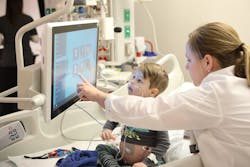Patient engagement has become a hot topic as many healthcare leaders see it as one strategy to help achieve the “Triple Aim” of improved health outcomes, better patient care and lower costs. While many healthcare provider organizations are deploying patient engagement strategies to connect with patients outside the four walls of the hospital, others are focused on improving the inpatient experience.
Senior executive leaders at the University of Iowa Health Care, the Iowa City-based health system that includes the 800-bed UI Hospitals and Clinics, saw an opportunity to leverage patient engagement technology solutions to supports its patient experience initiatives, with a specific focus on pediatric patients.
In July 2015, health system leaders worked with Oneview Healthcare, a healthcare technology company headquartered in Ireland and with offices in Chicago, to pilot the company’s interactive patient engagement and clinical workflow solution in a unit of the UI Children’s Hospital. At the time, health system leaders were planning and designing a new children’s hospital and wanted to test out the patient engagement technology with the idea of potentially deploying it in the new facility.
“We wanted to create that delightful experience for our patients and not just an entertainment system, but also something that really engages the patient, educates them about their care, gives them the ability to connect with their providers in a different way by leveraging technology,” Maia Hightower, M.D., chief medical information officer at UI Health Care, says.
Typically, from a patient experience perspective, during a hospital stay, the only entertainment and interactive technology that patients are provided are a television and a nurse call button. By deploying the Oneview platform in a pilot unit at UI Children’s Hospital, the pediatric patients in that unit were provided with their own personalized bedside touchscreen tablet that enables them to play video games and watch movies, as well as communicate directly with their care team and select and order meals. In addition, the platform enables communication with parents or caregivers outside the hospital via Skype-based texting and audio communication.
“Some patients stay quite a long time and we have parents who live quite far away. So, one of the other reasons why we choose Oneview was their ability to bring that parent into the child’s life here at the hospital. So, if the parents are at home there are able to talk to the kids at the hospital or be Skyped in during a clinical consultation,” Pamela Kunert, R.N., nursing informatics specialist at University of Iowa Hospitals and Clinics, says.
Based on the results of the pilot project, health system leaders decided to roll out the platform across the newly constructed, 199-bed UI Stead Family Children’s Hospital, which opened this past February.
photo credit: Jeffrey Becker, USA Today
The platform integrates with UI Health Care’s current enterprise-wide electronic medical record (EMR) and creates a personalized experience for patients, while also encouraging active collaboration with their clinicians on education and goals, and direct communication with their care teams.
While the entertainment features, such as video games and movies and TV programming are popular features with children who are pediatric patients, the platform also enhances the engagement children and their families have with physicians and clinicians, Kunert says. “We have the platform connected to our real-time locating system so it recognizes when a doctor or a care team member enters the room and provides the provider’s name and photo on the screen. In a large academic medical center, with so many people coming in and out, it can be a bit daunting for families to know who people are. So, that feature is helpful and can help to break the ice.”
The bedside touchscreen platform also provides personalized menus for patients targeted to their specific diets. “If a child is allergic to strawberries, any item with strawberries will not show up when that child orders food via Oneview. And the families and care givers can also help the child pre-order a meal if they won’t be here for a particular meal,” Kunert says.
Feedback from patients’ families also indicates that use of the technology platform gave parents more peace of mind about their child’s hospital stay. “Parents have said it keeps their child entertained and keeps their mind off where they are and why they are here,” Kunert says.
Since the technology platform has been implemented, patient experience scores have risen dramatically, from the 40th percentile to the 89th-90th percentile, Hightower says. “From an attribution standpoint, how do we say which part is Oneview and which part is the total patient experience, as we’ve made other changes? But, we’re happy that our patients are happy.”
The technology platform also enhances the patient education process, Kunert says. “Prior to implementing this technology, we had a lot of paper handouts for education or we had to get DVD players for kids to watch videos. Now when a nurse assigns a video in our EMR, that video will flow over into Oneview and the parent or the child can watch that video and it sends a notification back through Epic that the patient has viewed the video,” she says.
A future goal is to extend the patient experience post-discharge by enabling patients and their caregivers to watch patient education videos at home, via a link in the patient portal.
At UI Stead Family Children’s Hospital, a key technical challenge was integrating the Oneview platform with other systems in the hospital. “The number of integrations are amazing. Essentially, we used a middle ware strategy to help connect Oneview with Epic (EMR system) and with the nurse call system,” Hightower says.
She notes that senior IT leaders at the organization played a vital role in supporting the implementation of the technology. “There was a lot of investment and a real commitment to create a state-of-the-art children’s hospital, so with building a new children’s hospital with a lot of new technology, it was pretty easy to get senior leadership buy-in on this project. The senior leader who has been most instrumental along the way through implementation has been our CIO [Lee Carmen, CIO of UI Health Care]. That’s where the rubber meets the road. It takes a lot of commitment from the IT team to figure out all those integration points and technical process of implementing the product,” Hightower says.
Clinical and IT leaders say implementing the technology in a new hospital presented less challenges than rolling it out in an existing hospital. “With a new hospital, you have a blank canvas, versus our adult hospital, where you have to remodel wing by wing, it’s a little bit more challenging. The idea was to start with Children’s Hospital, use that experience and the lessons learned and then roll it out to the adult hospital when the opportunity arises,” Hightower says.
According to Oneview Healthcare, hospitals that have implemented the technology platform have seen increased patient satisfaction, with patients also more engaged and involved in their own care, leading to measurable improvements in patient outcomes. A study done at Epworth Eastern Hospital part of Epworth HealthCare, the largest not-for-profit private health care group representing 20 percent of all beds in the state of Victoria Australia, found that patients and families that used Oneview's solution to prepare for discharge with education, goal completion and real-time collaboration with their care teams, experienced a six percent reduction in their average length of stay.
At UI Health Care, implementing the patient engagement technology solution was not just a one-off project, but part of a larger strategy to provide patient-centered care. Hightower notes that patient experience is often incentivized as part of value-based payment models. “There are real dollars associated with high patient experience,” she says. “There are also shifting market factors that are increasing patient engagement in healthcare, in general, with the rise of consumerism in healthcare. Patients know that they have a choice in where they go. For many of our patients coming all over the state of Iowa, they are not that far from other health systems, where they can drive a couple of extra hours to Chicago.”
She continues, “In this era where patients really have choice, we want to make sure that we can provide outstanding quality of care, and that the overall experience is outstanding as well. We want to make sure that we are patient-centered in the way that we deliver care. It helps to have government incentives in payment to match, as well as the rising role of consumers and wanting to give patients an outstanding experience, in and of itself.”



